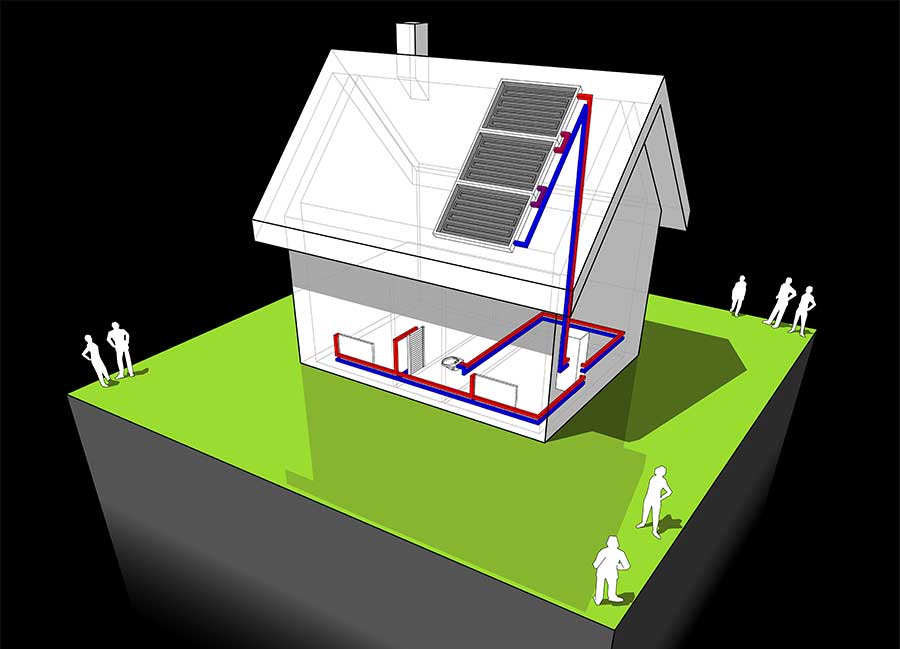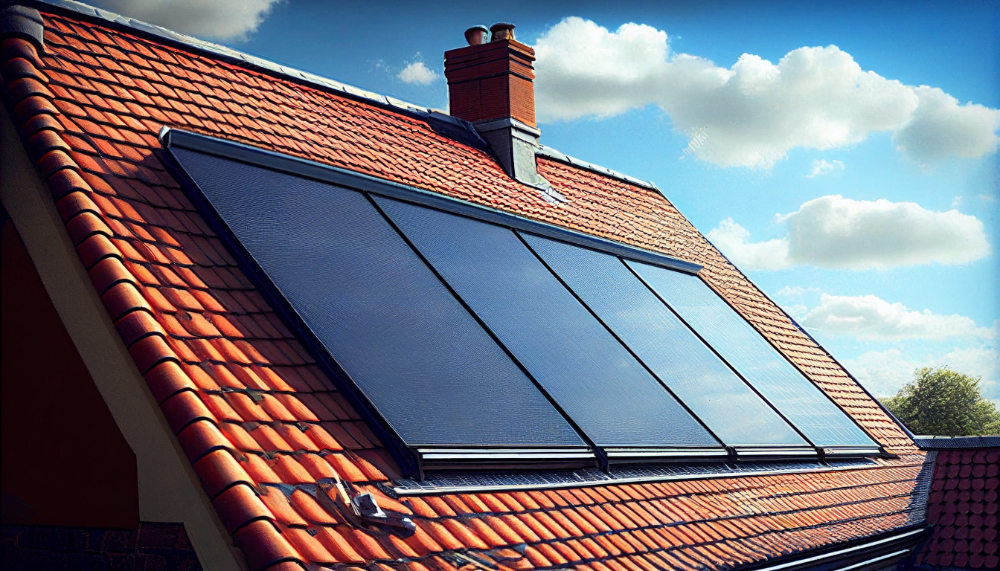- Home
- Scotland's changing climate
- Urban Housing in Scotland
- Maintenance
- Ventilation
- Airtightness
- Insulation
- Lofts - insulation at ceiling level
- Lofts - insulation at rafter level
- Cavity wall insulation
- Solid Walls: Internal vs External Insulation
- Internal Solid Wall Insulation (IWI)
- External Solid Wall Insulation (EWI)
- Timber frame retrofit
- Windows and doors
- Openings in 'historical' buildings
- Openings in 'non-historical' buildings
- Ground floors
- Suspended floors
- Suspended floors - from below
- Suspended floors - from above
- Solid floors
- Insulation materials
- Building science
- Space heating
- Solar energy
- Product Selector
Solar Thermal Hot Water
• Solar thermal panels mounted on the roof are a good source of hot water. They can provide up to 70% of your annual hot water needs - around 20% in winter and 100% in summer.
• They need to be mounted on a south-facing roof of a pitch of around 30° - 40°
• The common ‘flat panel’ technology is tried and tested and uncomplex.
• The simplest solar panels are like radiators painted black with cold water pumped through them, heated by the sun.
• A more sophisticated design is based on the ‘evacuated tube’ technology. It is more efficient but more expensive.
• The warmed-up water will be returned to a storage cylinder shared with another hot water-generating appliance, such as a gas or wood chip-fueled boiler.
Retrofitting Solar Thermal Panels
Retrofitting solar thermal hot water panels involves several steps and considerations. Solar thermal panels are designed to capture sunlight and convert it into heat, which can then be used to heat water for domestic use. Here's a general overview of how they are retrofitted:
1. Initial Assessment:
Determine if the building is suitable for solar thermal panels. Consider factors such as the orientation and pitch of the roof, shading from nearby buildings or trees, and the available space for installation.
2. Planning and Permissions:
Check if it needs planning permission or building regulations approval for the installation. Solar thermal panels are often considered permitted development, but it's essential to verify this with your local planning authority.
3. System Design:
Work with a qualified installer to design a solar thermal system that meets hot water needs. This includes selecting the appropriate size and type of solar collectors and the location for the hot water cylinder.
4. Installation:
• The installer will fit the solar collectors on the roof, ideally facing south or within 90 degrees of south, to maximise sun exposure. Proper mounting brackets and flashing are used to secure the panels in place.
• A heat transfer fluid (often a mixture of water and antifreeze) circulates through the panels, absorbing heat from the sun and transferring it to a heat exchanger.
• A solar hot water cylinder is installed in the home, connected to the solar panels and the existing hot water system.
5. Plumbing and Integration:
The system is integrated into the existing hot water setup. This typically involves connecting the solar hot water cylinder to the conventional water heater or boiler. A control system is installed to manage the flow of hot water between the solar system and the backup heating system.
6. Commissioning and Testing:
The installer will commission the system, ensuring that it operates correctly. They will check for leaks, test the circulation of the heat transfer fluid, and verify that the solar thermal system efficiently heats the water.
7. Maintenance:
Regular maintenance is essential to keep the system running efficiently. This includes checking for leaks, inspecting components, and ensuring that the heat transfer fluid is at the correct level and not degraded.
8. Government Incentives:
In the UK, there have been various government incentives and schemes to promote the installation of solar thermal systems, such as the Renewable Heat Incentive (RHI). Check for available incentives and subsidies to help offset the installation costs.
9. Monitoring and Optimization:
Consider installing monitoring equipment to track the performance of the system. This allows adjustments to be made as needed to optimise its efficiency.
Hiring a certified and experienced installer is important to ensure the proper design, installation, and maintenance of the solar thermal hot water system.
But beware ....
Retrofitting solar hot water panels can be a cost-effective way to harness renewable energy and reduce utility bills, but it also comes with some drawbacks and challenges. Here are some of the potential drawbacks:
1. Upfront Cost:
The initial cost of purchasing and installing solar hot water panels can be substantial. While incentives and rebates are often available, the upfront investment can still be a barrier for some homeowners.
2. Space Requirements:
Solar hot water panels typically require a significant amount of roof or ground space for installation. Not all homes have enough room or suitable orientation to accommodate these panels.
3. Aesthetic Impact:
Solar panels can alter the appearance of a home, which some homeowners may find unattractive. This can be a significant concern, especially for those in locations such as Conservation Areas.
4. Installation Complexity:
Retrofitting solar hot water panels can be a complex and time-consuming process. Proper installation requires expertise and may necessitate structural modifications to the building.
5. Weather Dependency:
Solar hot water panels rely on sunlight to function efficiently. In areas with frequent cloud cover or limited sunlight, the system's performance may be reduced, impacting its cost-effectiveness.
6. Maintenance and Repairs:
Like any mechanical system, solar hot water panels require regular maintenance to ensure they work efficiently. Panels must be cleaned, checked for leaks and component replacement over time. Maintenance costs can add up.
7. Energy Storage:
Solar hot water systems typically do not include energy storage. This means they can only provide hot water when the sun shines, so the system may still need backup water heating.
8. Compatibility Issues:
Retrofitting solar hot water panels can be challenging if the existing water heating system is incompatible. Upgrading or modifying the existing system may be necessary, which can increase the overall cost.
9. Regulatory and Permitting Issues:
Local regulations and planning permission may be required to install solar hot water panels. Dealing with these requirements can be time-consuming and add to the overall cost.
10. Resale Value:
While solar panels can add value to a home and reduce energy costs, not all homebuyers will appreciate their presence. The effect on the property's resale value can vary depending on market and buyer preferences.
11. Long Payback Period:
The return on investment for solar hot water panels can take several years to realise, and it may be slower than other solar technologies, like photovoltaic (PV) panels.
Despite these drawbacks, solar hot water panels can be a practical and environmentally friendly way to reduce energy costs and carbon footprint. Whether retrofitting is a good option will depend on specific circumstances, such as location, energy needs, and budget. It's essential to carefully consider these factors and conduct a thorough cost-benefit analysis before deciding.


'Traditional' flat plate collectors

The more efficient (and expensive) evacuated tube technology.